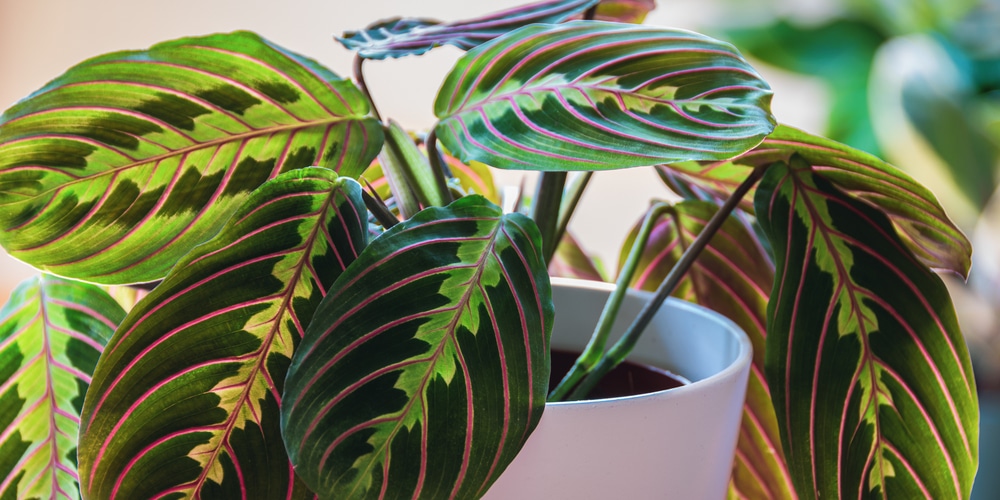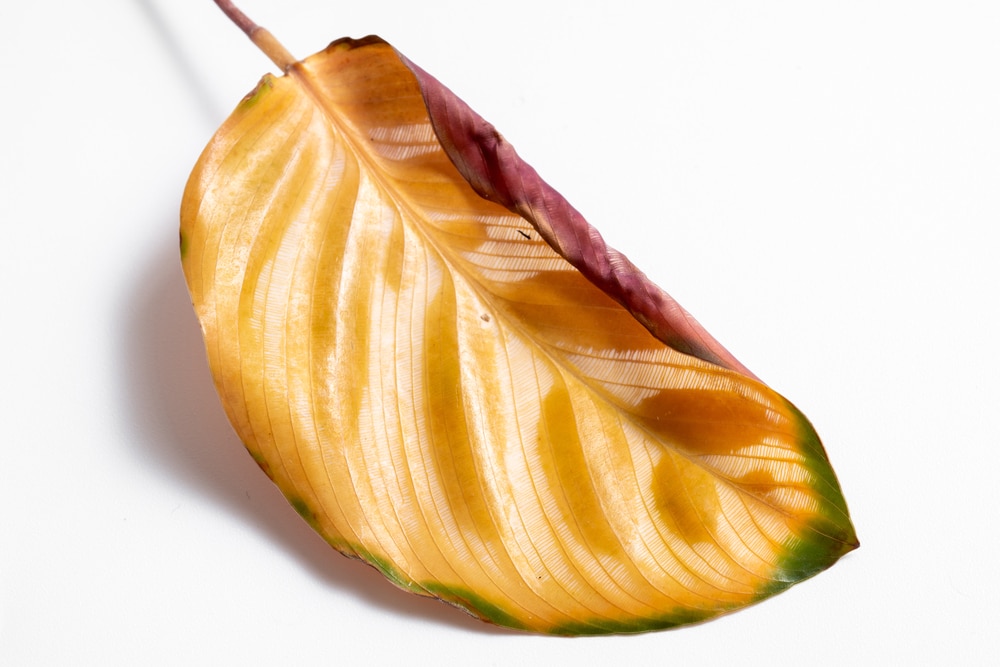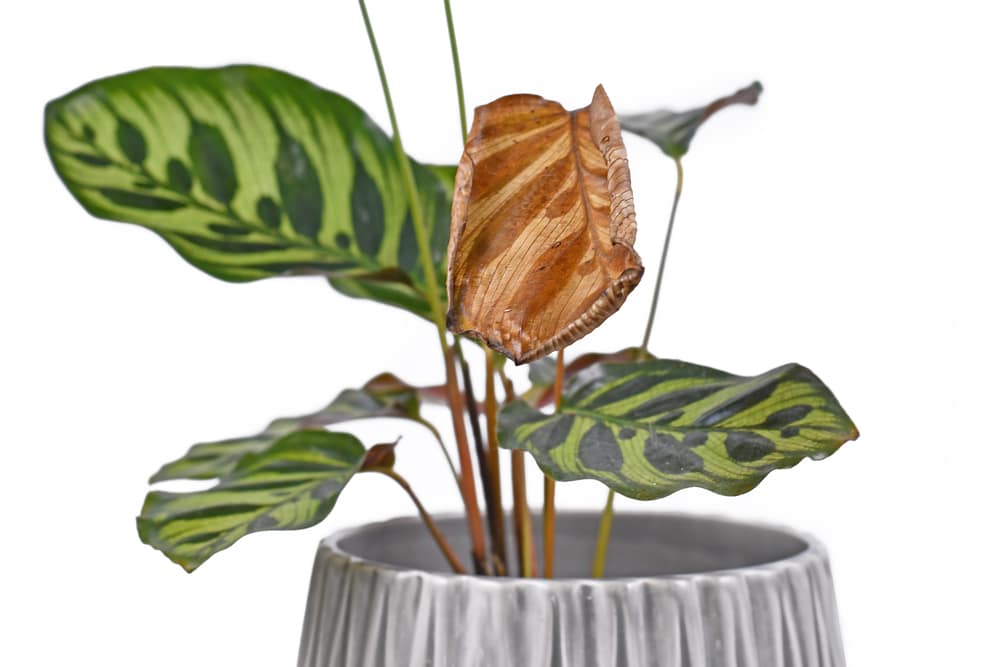Prayer plants are known for their beautiful, colorful leaves. However, sometimes prayer plants’ leaves turn yellow. There are several reasons why this might happen, and thankfully, there are also several solutions.
About the prayer plant

Prayer plants (Maranta leuconeura) are a species of flowering plant that is native to the Brazilian tropical forests. Prayer plants get their name from the way their leaves fold together at night, which resembles hands praying.
Prayer plants are known for their beautiful, decorative leaves. The most popular variety is the tri-color prayer plant. This one has green, velvety leaves that have arching red veins and yellow splotches throughout the mid-region.
This plant is a slow grower but it can reach a height of one foot in an indoor environment.
Growth requirements
A majority of the reasons that cause the prayer plant’s leaves to become yellow are connected to the care and growth requirements. As such, it’s a good idea to understand what the prayer plant needs in order to grow properly.
Care level
The prayer plant is an easy or low-maintenance plant. This means that it doesn’t need a lot of care and attention
USDA hardiness zone
This plant thrives best in zones 11-12
Light
Prayer plants need bright, indirect sunlight. If the plant isn’t getting enough light, the leaves will begin to turn yellow.
Conversely, if the plant is getting too much direct sunlight, the leaves will start to turn brown and crispy as a result of sunburn.
Temperature
The ideal temperature for a prayer plant is between 65-85 degrees Fahrenheit (18-30 degrees celsius). You will want to avoid temperatures that are below 55°F (12.8°C) at all costs.
Humidity
Prayer plants grow best when put in an environment with an above-average to high humidity (60% and above).
Water
Prayer plants like to be moist but not soggy. The best time to water is after 25% of the soil at the top starts to dry out. This is approximately 1-2 times each week depending on the environmental conditions.
Soil requirements
A prayer plant will appreciate well-drained, moist, and nutrient-rich soil. It should be slightly acidic soil (pH 5.5-6.0), that is well-aerated.
Fertilizer
You will want to feed your prayer plant once per month during spring and summer using liquid houseplant fertilizer.
Pruning
Getting rid of damaged, dead, or dry leaves will help the overall appearance of your prayer plant. It will also help to encourage new growth.
You can remove a couple of stems during the growing months to encourage branching as well as promote growth. Just be sure to use sterilized gardening scissors.
Repotting
It’s recommended that you re-pot your prayer plant every 2-3 years, or when the plant is root-bound.
Reasons and fixes for yellowing leaves
If your prayer plant’s leaves are turning yellow, it’s likely due to one of the following reasons:
1. Watering issues
Either you are over or underwatering your prayer plant. Leave yellowing in prayer plants is mainly the result of excess watering. That’s mainly because soggy soils will reduce the aeration of your soil, while also making it difficult for the roots to absorb water and minerals.
Since water has a contribution to chlorophyll manufacture, a change in the pigmentation of your plant’s leaves is one of the many signs that something is wrong with its watering.
Solution:
The good thing about watering as an issue that is likely to cause yellowing in prayer plants is that it’s quite easy to correct. Just make sure that you allow the top 1 inch of the soil to almost become dry between watering sessions.
2. Too little light
If you place your plant in a dark room or corner, the leaves will start to have a whitish-yellowish pigmentation. That’s because the plant is unable to make chlorophyll and food.
In extreme cases of inadequate sunlight exposure, the leaves will become pale and then fall off the plant.
Solution:
To prevent your prayer plant from having insufficient light, you should place it somewhere where it can get bright, indirect sunlight. If your house is quite dark, you may have to get grow lights.
3. Too much sunlight
Exposure of the prayer plant to excess direct sunlight can damage its chlorophyll, resulting in yellow leaves or yellow scorch mark patches on the leaves.
The leaves may also have crispy brown margins and tips and will look as if they have been burned. They may curl and droop but won’t fall off the plant immediately.
Solution:
To save your prayer plant from too much sunlight, you should move it away from the window or place it behind a sheer curtain. Just make sure that your plant is in a place where it’s getting just enough direct sunlight.
Having your plant too close to a south-facing window is not a good idea, since the hot afternoon sun is likely to burn the leaves. If growing the plant outdoors, put it in a spot where it will get some shade during the hottest hours of the day. You can even use a shade cloth if necessary.
4. Incorrect temperature
Prayer plants are tropical plants that prefer warm temperatures and high humidity. They will do poorly in low humidity and cold conditions.
If the leaves of your prayer plant start to turn yellow, brown, black, or white, it’s likely because the temperature is too low. The leaves may also become papery and dry, and the plant will stop growing.
Solution:
To prevent your prayer plant from getting too cold, you should keep it in a room that has a temperature between 65 and 85 degrees Fahrenheit. If the temperature drops below 55 degrees Fahrenheit, make it a priority to move your plant to a warmer location.
5. Too much fertilizer
Prayer plants are not heavy feeders, so you don’t need to fertilize them too often. Using too much fertilizer makes the plant have an appearance that is close to the sun-scorched appearance.
Besides, some fertilizers can even change the soil pH, and this may affect the availability of vital minerals such as iron.
Solution:
To prevent your prayer plant from getting too much fertilizer, you should only fertilize it once a month during the spring and summer. Use diluted, water-soluble houseplant fertilizer.
6. Pest infestation
Pests such as spider mites, mealybugs, thrips, and Aphids are likely to cause yellowing in prayer plants. These pests feed on the plant’s sap, which will cause the leaves to turn yellow and eventually drop off. Some even inject toxins into leaves, reducing chlorophyll production.
Solution:
If you think your prayer plant has a pest infestation, you should spray the plant with water to remove the pests. You can also use insecticidal soap, horticultural spray oils, or neem oil in the case of severe infestations.
7. Low humidity
Prayer plants come from tropical regions and prefer high humidity. If the air around your plant is too dry, the leaves will start to turn yellow and brownish. The tips of the leaves may also become crispy and dry.
Solution:
To increase the humidity around your prayer plant, you can use a humidifier, mist the plant preferably once every week, or place it on a pebble tray. You can also group your plants together to increase the humidity.
8. Lack of iron
If your prayer plant is not getting enough iron, the leaves will start to turn yellow due to a reduction in the production of chlorophyll. This may happen if the pH level of the soil is too high, such that iron becomes less available for uptake by the plant.
Solution:
To prevent your prayer plant from lacking iron, you should check the pH level of the soil and make sure it’s between 6.0 and 7.0. You can also use a chelated iron supplement to correct the problem.
Prayer Plant Yellow Leaves: Final word
These are the most common causes of prayer plant yellow leaves. Keep in mind that there are normal reasons for leaves yellowing in prayer plants. The two main normal reasons are plant shock after transplanting and aging.
In the case of abnormal yellowing, taking the necessary steps to correct the problem will allow you to bring your plant back to good health in no time!


